Filthy Lucre: how money has helped to shape Australian ceramics over the past half century
“The best things in life are free
But you can keep them for the birds and bees Now gimme money (that’s what I want) ”
Nostalgia can be comforting, but it’s all too easy to wallow in a past that was really more like the present than one likes to think.
The Gordy/Bradford song was playing around the time Pottery in Australia was first published in 1962; Robert Menzies was Prime Minister, and EK Holdens were rolling off the production line, and tended to (forgive the tortured metaphor) paint a picture of Australian ceramics in, if not sepia tones, then at least colours reminiscent of an old Kodachrome slide. We think of it as being far removed from what happens now, but the reality is that only a few changes have occurred in Australian ceramics over the past five decades, and those changes, important though they are, are probably not the ones we expect to find.
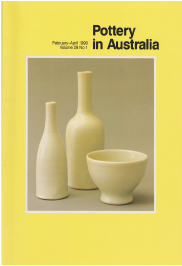
For a start, not a lot has altered in the sort of work that is made. Ceramics can still be separated into the same categories of objects that it occupied fifty years ago; namely, vessel-based work and everything else. There may be a quibble about when ceramics becomes sculpture or at what point a pot becomes
a representation of a pot, but, for the purposes of this discussion, I’m contending that nothing new has arrived on the scene during the past half century.
We’ve had faux Sung and faux just about everything Japanese, Modernism, Funk, Memphis, Post Modernism, Cool Porcelain, Designer Groupings, Conceptual Clay and God knows what else. Even the seemingly recent innovation of installations date back at least to the mid-seventies.1 Some styles seem to have come and gone while others have endured, but perhaps the only really notable change in all that time has been a shift in interest away from brown clay, once the staple of Australian potters, to the almost universal use of white clays, particularly porcelain.
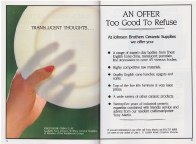
This preference for etiolation also touches on the question of techniques and materials, but again very little has actually changed. Earthenware pottery, once the mainstay of early Australian studio pottery, made quite a comeback in the 1970s and 80s, while the fetish for porcelain has continued to grow, making the wide brown land into the great Southern Ice-land. Although the use of more ‘natural’ materials has diminished, the woodfirers still show a significant commitment to a ‘back-to-nature’ approach, even if that means utilising pre-packaged and specially formulated clay that will react nicely to a three-day firing in an anagama. (And just trying to say “in an anagama” surely deserves some sort of prize.)
Shifting our attention to how ceramics is taught, it seems that here at least there have been some significant shifts, with the precipitous decline of ceramics as a discrete subject within the art curriculum being the most radical change of all. Nonetheless, what has remained constant is that the teaching of ceramics to adults has mainly been undertaken by tertiary institutions as part of the ‘higher education’ sector – bodies funded by the government that award qualifications of various sorts.
An unexpected consequence of this situation has been the proliferation of ceramicists who now possess higher degrees, but this says more about the way art schools have been incorporated into the university sector than it does about the work that is made. Universities are funded to do research and they take every opportunity to frame their activities within these guidelines, so if an art school is part of a university it is only reasonable to expect that some students will take matters to a logical academic conclusion.
There are several other possible approaches as to how ceramics might have been taught, but few of these met with any success. Despite some valiant attempts to set up government-funded apprenticeships, this approach never caught on, and privately funded apprenticeships were always destined to fail in a country where the teacher could hardly earn enough from the sales of work to support themselves, let alone a trainee. The other approach, where ceramics was taught as a genuine trade, wasn’t ever really a starter, since traditional ceramics manufacturers were dying out by the time the post war crafts movement had taken hold.
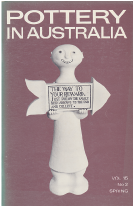
Despite this reliance on the art school system, the position of ceramics within the marketplace has always been more ambiguous, with goods appearing in venues ranging from high-end galleries to craft shops, private showrooms and even stalls in local markets. Sometimes a ceramicist would place work in all of these venues simultaneously, showing a promiscuous disregard for the niceties that constrained more mainstream artists and helped defined their practice.
Maybe the only consistent factor in Australian ceramics has been its continuing marginality; always one sandwich short of a picnic as far as the art world was concerned, and increasingly fated to be on the decline with a general public spoiled for choice in a modern consumer paradise. In fact, it is this last observation which points to the factor that has conditioned every aspect of the development of Australian ceramics, from the amateur to the professional, from academia to the marketplace, in both the public and private sectors, and that is money.
Money may indeed be the root of all evil2 (actually this is a malapropism – the original quote suggests that the love of money is the problem) but the economy of the crafts, how money is earned and distributed within a community of makers and consumers, has shaped Australian clay as surely as the hands of a skilled craftsperson.
To see how this has happened, we must go back to the late 1940s when legions of returned servicemen, aided by government funded retraining schemes, enrolled in courses in art schools and technical colleges throughout the country. Although ceramics was only a very small part of what was on offer it did allow some students to experience clay for the first time and to consider that some form of artistic expression could be a part of their lives.
In addition to this, the ending of the period of wartime austerity had led to a proliferation of small ceramics manufacturing concerns. The Australian public were hungry for goods, and potteries across the country sated the desire of the consumer for colourful, relatively inexpensive items that faced little domestic competition in a highly protected market. The work may have been earthenware, and some may have despised the seemingly endless supply of eggcups and ramekins that flooded the market, but it was a business with a sound economic base.
At the same time, growing numbers of Australian potters, inspired by Bernard Leach’s A Potter’s Book, embraced the challenges of stoneware. The aesthetic was different and the technology presented many challenges, which doubtless was part of the appeal and explains the tendency of ceramics magazines to include copious amounts of technical information. There was a ready market for this new style of work, as it fitted well with the more avant-garde trends in architecture and homewares, although whether it ever had the same level of mass appeal as earthenware is debatable.
Growing numbers of commercial galleries exhibited ceramics and, because of the good prospects for sales, commissions were low and galleries wouldn’t dream of charging up-front costs. Exhibitions often sold out, and there are wonderful stories of gallery directors rationing sales to eager customers, such was the interest in this new field of studio pottery. However, the major development in the ceramics economy concerned the increasing amounts of public money flowing to the crafts. There were two main sources of this extraordinary largesse.
The first was the proliferation of government-funded ceramics training courses. In departments of further education, in vocational training and at art schools, the 1960s and ’70s saw an exponential rise in the adult education sector. Since ceramics was often a part of the school curriculum, teacher training colleges incorporated ceramics departments as well.
The result was that by the mid-70s even a small state might have a dozen or more fully functioning ceramics departments scattered throughout the metropolitan and regional areas. Many of these institutions offered a range of courses, with part-time and after hours ceramics classes being very well attended indeed.
All of these departments needed to be staffed and equipped, and a reasonably talented ceramicist might well look forward to gaining at least some of their income from teaching, with the most fortunate ones being offered the sinecure of a tenured position, together with generous working conditions and the prospect of a highly subsidised superannuation scheme on their retirement.
We also shouldn’t forget the students who, thanks to the Whitlam years, now had access not only to free education but a student allowance that provided (just) enough money to live on, which led to ever greater numbers of people moving through the art departments.
If this era saw an expansion of the higher education sector, it also witnessed another facet of government support for the crafts, which was the introduction of the grant, or should that be the GRANT.
As Grace Cochrane notes:
“Towards the end of the 1960s, the first moves were made to rationalise and co-ordinate the ways in which the federal government funded the arts, a development that was to reach its fullest form in the reshaped Australia Council for the Arts in 1973.”3
The newly elected Prime Minister, Gough Whitlam, called on Jean Battersby, the CEO of the then Australia Council (originally an organisation mainly concerned with funding the performing arts), to prepare a report for the new government that highlighted the administrative and, from a strongly centralist government’s point of view, philosophical problems presented in overseeing the raft of existing arts funding bodies.4
Predictably enough, Battersby found that, “... the present situation is not satisfactory from an administrative point of view ...”5 To conjure the blessed spirit of Sir Humphrey Appleby, “steps needed to be taken”.
After all, Whitlam, with characteristic hyperbole, had stressed the importance of the arts to his new government, stating that,
“... all the other objectives of the Labor government – social reform, justice and equity in the provision of social services and educational opportunities – have as their goal the creation of a society in which the arts can flourish”.6
Never one to waste time, on Australia Day 26 January 1973, Whitlam announced the first appointments to a new arts council, comprising seven specialist boards, of which the Crafts Board was one. For the first time, the crafts had a seat at the adult table.
State governments followed suit, allocating funds through newly created departments of the arts to local crafts boards, which were often also funded by the Australia Council. Offices were rented, staff appointed and these organisations, state and federal, came to control the purse strings.
Not that the strings were drawn very tightly, at least in the beginning. Fiscal rectitude was not one of Gough’s strong points, and activities that had hitherto seemed to be the domain of the hobbyist – basket-weaving and the like – soon found themselves being encouraged and given financial support, and the mechanism by which this was achieved was the grant.
In an interesting historical coincidence, it was at about this time that the influence of a mainly American school of avant-garde ceramics, transmitted through the pages of that esteemed journal Craft Horizons, really began to be felt in this country.
This was a new type of ceramic work that was at the very forefront of post-modernism, revelling in its ‘dumbing down’ of high-art pretensions and poking fun at the rather serious and tasteful world of studio pottery. Unfortunately, these new ceramic objects were mostly unsaleable, and it is here that we begin to see the negative side of a system that supported artists to make things the public simply didn’t want.
This is such a complex equation that unravelling all the permutations should be the subject of at least one PhD. Suffice to say that the combination of providing government assistance for individuals to make work, together with rewarding many of those same individuals with teaching positions, as well as generously funding non-commercial gallery spaces to show work which was going to be very difficult to sell, led to a situation where many ceramicists didn’t take the attitudes of the general public into consideration at all, because they had no financial incentive to do so. This represented a paradigm shift in the relationship between Australian ceramicists and a public that had hitherto supported the crafts in a fairly enthusiastic manner.
There began an inevitable drift away from ceramics. Ceramics departments began to close down and the student numbers dwindled. The new management-driven class of education administrators (whose numbers were actually rising!) used this as an excuse to close more courses, and it just went on from there. Private galleries weren’t as willing to exhibit ceramics, because the sales had begun to drop off. They also charged a lot more for the privilege, regularly demanding up-front fees to cover costs, a punitive economic burden which the artist frequently tried to defray by – you guessed it – applying for a grant. Ironically, this practice was also adopted by government-funded spaces that found themselves in the privileged position of being paid (how shall I put this delicately?) to both give and receive at the same time.
Amidst all this discussion of the role of government in shaping Australian ceramics, what is to be said of the ultimate consumer, the so-called general public? What role have they played in all of this?
Tastes certainly do change, as does the availability of goods, and with it the way people choose to spend their money.
In the heyday of the crafts, inner-city shopping precincts barely had a coffee shop or restaurant to their name. Whole categories of modern consumer goods simply didn’t exist. This is significant because spending on the crafts is discretionary. The funds can just as easily be spent on something else, for example anything beginning with a lower-case ‘i’, or eating out.
Shops are now full of ridiculously cheap ceramics, mostly, but not exclusively imported from China, a country which has been pretty good at cornering a global market for export ceramics for over five hundred years. Whereas you simply couldn’t go into a store in the 1960s or ’70s and buy a nice set of plain white noodle bowls for a couple of dollars each, now you can get them at the supermarket. This is pretty serious competition for a potter who makes functional wares and it takes a very informed and dedicated consumer to spot the difference.
In the end, perhaps all one can really say is that in ceramics the distribution of government money
has had a definite impact on what is made, but then again so has the normal ebb and flow of the marketplace. The final arbiter of the arts economy is actually the secondary market, which is about as free as the free market gets, “... Nature, red in tooth and claw ...”7, though I don’t think Tennyson had Sotheby’s in mind when he came up with the phrase. It will probably take another fifty years to sort it all out.
Damon Moon
Willunga, 2012
- For example, Eros in Porcelain, an exhibition by the then Adelaide-based ceramicist Mark Thompson at the S.A. Craft Authority Gallery in May, 1976. A detailed review of this exhibition, written by Dick Richards, can be found in Pottery in Australia, Vol.15, No.2 p.66
- Timothy, chapter 6 verse 10
- Grace Cochrane, The Crafts Movement in Australia: a history, p.135 New South Wales University Press, 1992
- www.aph.gov.au/Library/pubs/BN/2008-9/ArtsPolicy.htm from a document prepared by Dr. John Gardiner-Garden 5 Jean Battersby, First Annual Report, January to December 1973 Australia Council for the Arts, 1973 p. 9
- Gough Whitlam, The Whitlam Government 1972–75, Viking 1985 p. 553
- Alfred Lord Tennyson, In Memorium A.H.H., 1850 (canto 55)
Gwyn Hanssen Pigott
“Instead, the things ... seep deliberately into one’s attention. They start vaguely, as little more than silhouettes, a vibration of one low colour against another. Gradually they ‘develop’ on the eye, and
one begins to grasp their internal relationships: how articulate the subtle sequence of tones may be,
in a form that once looked flat and brown; how many colours may be contained, as dusty hints and pearly afterimages of themselves, in what seemed to be a sequence of grey patches. If the straight side of a bottle seems to waver, it does so only to remind us how mutable and hard to fix the act of seeing really is. And if the shapes look simple, their simplicity is extremely deceptive; one recognises in it the distillation of an intensely pure sensibility, under whose gaze the size ... the silence of the motif and the inwardness of the vision are as one.”1
If not for the omission of six words in the passage above it might be assumed this article was one of the many recent tributes to the work of the late Australian potter Gwyn Hanssen Pigott, who passed away in London in July this year at the age of 78.
The missing words are ‘in his paintings’ and ‘of the painting’ and the 1981 essay by Robert Hughes is about the Italian painter Giorgio Morandi, an artist who profoundly influenced Hanssen Pigott’s work and to whom history may apply a similar judgement of being a petit-maître, an artist who “... although (they) said it very well, had only one thing to say”.2
These assessments will be made and contested over time, but it is true to say that the reputation of Gwyn Hanssen Pigott as Australia’s most significant, internationally recognised ceramicist, is predicated on a body of work that took one idea and, balancing a sound knowledge of her craft with an acute sensibility, parlayed that work into a career that I doubt she could ever have foreseen.
In contrast to the rather hagiographic tributes being written about her life in ceramics, Gwyn’s progress did not always chart a smooth and steady rise. Nonetheless, her beginnings in ceramics are not so far removed from where they ended, especially when one takes into account the myriad digressions that have characterised the field over the last sixty years.
Several factors influenced her early career. As a student of Fine Arts at the University of Melbourne she had ready access to the Kent Collection of Chinese ceramics at the National Gallery of Victoria, which at the time was the only readily accessible holding of historically significant Asian ceramics in the country. In an unusual but prescient move, Joseph Burke, then Head of Art History at the university, allowed her to research contemporary Australian pottery for her thesis. The Melbourne potter Harold Hughan introduced her to Bernard Leach’s A Potter’s Book, and so Leach’s persuasive arguments for the virtues of hand-made pottery, with its apotheosis in the ‘Sung standard’, could be immediately reinforced – ‘proved’ almost – by simply viewing the objects laid out before her in the gallery.
With Hanssen Pigott’s vision of ceramics having been realised (almost before it was formed) by the timeless beauty of classical Chinese wares, she quickly navigated the sea of rambunctious and gaudy earthenware that dominated Australian ceramics until “a very young nineteen-year-old in a dirndl skirt”3 arrived at the Sturt craft workshops in New South Wales where she met the potter Ivan McMeekin. There would be no turning back.
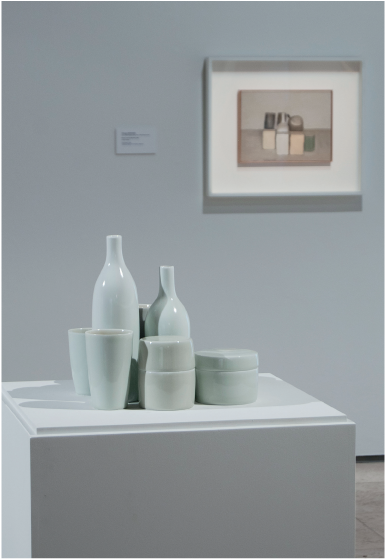
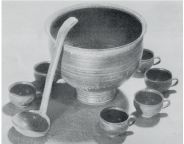
For Ivan McMeekin, who spent time in China before studying in England with Leach and Michael Cardew, the ‘Sung standard’ was accepted without question. When McMeekin returned to Australia from England to set up the ceramics workshop at Sturt, he sought to reproduce as closely as possible the classic wares of China, despite being separated from that originating culture by vast stretches of time and distance, and perhaps even of need. But McMeekin was tenacious and utterly convinced of his path and where he single-mindedly led, his young student followed. She took pressure off McMeekin by assuming responsibility for some of the teaching at Sturt, helpfully translating from the French the letters of the seventeenth-century Jesuit missionary Pere D’Entrocolles concerning Chinese porcelain manufacture, while digging for clay amongst the gum trees of the Southern Highlands in New South Wales.
When, with McMeekin’s blessing, she went to England in the late 1950s, Gwyn Hanssen Pigott set about furthering her education in ceramics at a time when Bernard Leach was the dominant figure and when his early apprentices were now leaders in their own right. Despite her commitment to this rather conservative approach to studio pottery, she also brushed up against a gentle version of modernism in London, where potters like Lucie Rie and Hans Coper had brought a ‘Continental’ sensibility to the field.
Gwyn Hanssen, as she was then, began to make a name for herself in London. Contemporary commentators remarked on her work as being “... completely acceptable ... a potter’s potter ...” 4 whose work “... more or less summarises the Leach-Cardew-Davis-Finch field ... akin to the work of the Mackenzie’s in the USA and McMeekin in Australia”.5 Pottery that belonged to the tradition of “Workshop potters versus art school potters. Useful-ware potters versus sculptor-painter-potters”6, this last observation having particular resonance when viewed in the light of her later work.
A typical example of her output at the time, from a 1962 exhibition at Primavera gallery in London, was almost a craft cliché: a ‘punch set’ consisting of cups with handles, a large, footed bowl and a ceramic ladle, all in muted, ash-glazed stoneware. And although Alison Britten, writing of this period in her essay ‘Gwyn Hanssen Pigott: a view from her second home’7, recalls that she represented a “... benchmark of sound and sensitive practice ...”8, other commentators had a different view, with Robert Melville, writing a few years earlier in Architectural Review, remarking that much of the ceramics coming out of the crafts movement seemed to belong to a “... village and market town community of highly aesthetic peasants ...”9
Gwyn Hanssen Pigott would soon reinforce this commitment to tradition (and here the word ‘tradition’ needs to be understood as being as much notional as factual) and by the mid-sixties, inspired by the simple beauty of French domestic pottery, she had settled in the district of Haut-Berry a few hours south of Paris. She built a large woodfired kiln and used local materials in a direct extension of McMeekin’s purist methodologies, which he in turn had inherited from Leach. (In truth, Leach was quite willing to modify his purist approach for the sake of expediency – it was more the early students like Michael Cardew and Harry Davis who took some of his philosophical urgings to what can only be described as fanatical extremes.)
She made pots in France and travelled often to England, where she supplemented her income by teaching at various art schools. Gwyn Hanssen Pigott had become a highly regarded maker of functional pottery, as good as any in the business. She was also very aware of the contradictions and paradoxes that ran through this modern, largely middle-class obsession with traditions that had faded away, when as early as 1969 she wrote that “... we younger potters ... can never be ‘potters of Haut-Berry’ ... we can never recapture the spirit that has passed. We remain, as ever, our immigrant selves, alone always, our work our own personal struggle and delight”.10
Later she recalled that she had “... tried ... to make something which would be real. I hoped that if I lived like a traditional potter somehow I would make pots like those unpretentious craftsmen in times gone by. But in fact I wasn’t unpretentious at all – nor simple ... I was acting a part that I hadn’t the strength for, and I was caught in a very subtle ambition to which I saw no end”.11
What is apparent from this statement is that Hanssen Pigott already had the ability to see beyond the objects she was making in order to interrogate their place in the world and, by extension, to question her own role as a contemporary craftsperson. This ability (which is rarer than one might think) does not necessarily lead to comfortable conclusions, and it probably contributed to her decision to leave her “... French idyll taking only what I could carry in my bag”.12
In 1973 Gwyn Hanssen Pigott returned to Australia. She worked for a while in New South Wales, and in 1974 moved to Tasmania where, with her student and future husband John Pigott, she established
a pottery near Hobart. During this time she returned to the methodologies that had characterised her work in France, making functional ceramics from locally sourced materials. The curator of Hanssen Pigott’s 2006 retrospective exhibition at the National Gallery of Victoria, Jason Smith, states that this time shows her “starting again”13, but she was also repeating herself, just in another place.
Her move in 1980 to the JamFactory workshops in South Australia resulted in a more substantial shift in her working practice, in that she found a way by which the effects she sought could be achieved more efficiently, albeit without any significant alteration to the final product. As ever, change in Hanssen Pigott’s work came incrementally. Change in location happened more frequently.
In 1981 she moved to Brisbane, becoming a resident potter at the Kelvin Grove campus of what is now the Queensland University of Technology. Over the next eight years, Hanssen Pigott continued to make functional pottery, even pursuing the decorated surface before “... reinvesting in simplicity ...”14
If functional, production-based pottery had maintained a certain cachet during the sixties and seventies, by the 1980s its allure was wearing a bit thin. The challenges first mounted on the Leach- derived studio pottery tradition by modernism and the Funk movement had evolved into a myriad of divergent styles; all clamouring for attention, all given equal time within the ceramics community, all suffering from the same lack of critical analysis that typified the discourses surrounding the Crafts and – with one or two possible exceptions - all being ignored by those working in the fine arts.
Working in the environment of an art school, the widening rift between ceramics made as art and studio-pottery was apparent. As Jeff Shaw, then Head of Kelvin Grove CAE, wrote of a 1983 exhibition of Hanssen Pigott’s work at Blackfriars Gallery in Sydney: “Gwyn’s ware is simply practical and simply beautiful, unpretentious but carefully considered. It is a pleasure to use and view.”15 Which is all very nice, but it doesn’t make it art and it meant that, as Jason Smith notes, Hanssen Pigott was increasingly being written out of the critical discourse.16
And then something happened.
The precise moment that Gwyn Hanssen Pigott began to group her pots together as a statement may never be known. The transition from casually observing thousands of pots sitting side by side on ware- boards or in the kiln, a familiar
sight to anyone who, like Hanssen Pigott, was a production potter, to the conscious grouping together of objects so that the whole was more than the sum of the parts probably happened slowly. Those who knew her from earlier times comment that she often would take great care in selecting and placing objects in her own home, with the same degree of care and control that typified her approach to all aspects of her craft.

A grouping titled Three Inseparable Bowls was exhibited at the Gary Anderson Gallery in Sydney in November 1987 and her adoption by this dealer gallery, more known for representing fine artists than craftspeople, certainly played its part in situating her work within a wider context. (Interestingly, the Gary Anderson Gallery staged a group exhibition in 1990 titled Homage to Morandi which featured many well-known artists, including Alan Mittleman, John Peart, Leonard Brown and Kevin Lincoln.)
A picture of Hanssen Pigott’s 1987 work, together with a short artist’s statement, can be found in the February 1988 edition of Pottery in Australia and it marks a bellwether moment in Australian ceramic history. Hanssen Pigott states that the “... bowls, bottles, beakers or teapots (are) ... meant as much for contemplation as for use; but whether studying them will yield any sense of meaning is questionable. They are only about themselves and about the years of needing to make them ... I can’t offer them as new, surprising, noble or comfortable. I have to make them because they are beautiful, worth the trouble”.17
There may be some argument as to whether these three bowls, taken individually, were new (metaphorically if not literally). The term ‘surprising’ doesn’t spring to mind; they were comfortable in the sense that were in no way challenging, and as to the question of nobility – well, “What poor an instrument, may do a noble deed”18 probably sums it up, if one takes poor to mean humble, or even self-effacing.
But that is if the pieces are seen individually, which of course they can’t be because they were ‘inseparable’, and therefore were one. Viewed through the finely tuned lens of Hanssen Pigott’s later work, these three bowls are very much a beginning. They only hint at what might come, but their significance to the artist is demonstrated by her reference to a poem which reads:
Some men go ten years without crying and when they do cry
it’s only because they feel utterly helpless. (Gerry Gilbert)
Here, she is wrapping the work in text, and the reader is to understand that the pots are inseparable not only from each other but from meaning with a capital ‘M’. She had found a way for her pots to be something other than just objects of use, an ambition which she had held for some time. It wasn’t a major work, but all the elements were there – it just took a few more years to refine things.
For a good part of her life, in Australia, England and France, Gwyn Hanssen Pigott made beautifully crafted domestic pottery when most attention was being paid and most accolades were being given to work that existed at the extremes of aesthetics. She made quiet pots during a period when the volume was turned up to eleven. Lou Reed once said to a heckler in an audience, “I can drown you out”, and there was a time in Gwyn Hanssen Pigott’s mid-career when that seemed to be her fate.
As Steve Dow noted in his article on Hanssen Pigott, although she “... never called herself an artist and hated the word ceramist ...”19, it was only when her work became contextualised as art that the mainstream arts commentators – those whose purview extends beyond the confines of the ceramics world, or simply exists outside it – began to vociferously proclaim the value of its craft origins, neatly packaged as it was within a familiar and highly recognisable pictorial language.
When the critic Christopher Allen, recently writing in The Australian in an article tellingly titled ‘Ceramist’s picture-perfect suites’20, states that “... in the 1980s, a particularly ill-conceived hybrid art form arose, known as ceramic sculpture, embraced largely by women and supported by an ill-digested mixture of theories about craft, folk-art and feminism”21, the products of which “... varied from faux-naif whimsy to ideological kitsch ... almost (all) uniformly dreadful”22, one gets a pretty accurate appraisal of how many in the art world viewed much of what was celebrated within the ceramics world. Those who worked in the fine arts wanted potters to be potters, while many of those in the ceramics world desperately wanted to be considered artists. Paradoxically, the fine arts contingent felt quite content to relegate all ceramics to a position somewhat below art, until a potter presented them with work which, quite literally, looked like art, while still being pottery.
By the early 1990s Hanssen Pigott’s work had arrived at its final configuration.
The groupings of pots now included taller shapes as well as bowls and beakers, teapots and cups. The early work, made at Netherdale in Queensland where Hanssen Pigott had moved in 1989, was a little clunky – the odd, elongated cone shapes of the vases were more smoke-stack than fragile Morandi, especially when glazed in the darker tenmoku blacks and browns; but by the mid-1990s it was pretty well all there, with the fine porcelain clays clothed in exquisitely nuanced whites and ivory creams through the palest blues, greens and yellows. The bottle shapes were more resolved, the cylindrical beakers and bowls had lost the broad French peasant foot and, seen individually, each piece became almost the idea of a pot, or perhaps the ideal. All of Gwyn Hanssen Pigott’s considerable technical skills were brought to bear on the simplest and most pared-down of objects, which, when gathered together
in groups of three or four or even twenty or more, achieved a kind of critical mass fuelled by their shared simplicity. It was a case of less is more and more of less, more or less.
As the groupings became increasingly larger, so did her reputation. She showed extensively in both Australia and overseas and obtained representation at galleries that had hitherto been merely unobtainable goals for Australian ceramics artists, or indeed any Australian artist.
In 2000 she moved back to South East Queensland, and over the next decade exhibited her pots at the highest level in Canada, the USA, England, Europe and Asia. In Australia her work broke boundaries as well as records for the kind of prices a living potter could achieve. She was the one who made it, and in doing so she paved the way for others to follow.
There is much to analyse in Gwyn Hanssen Pigott’s later work, far more than can be done in an
essay like this. Her arrangements of historical collections at museums like the Smithsonian are just one example of an artist whose oeuvre straddles art, craft, curatorial intervention and interior design in a bravura display of ... well, that is still to be decided. Beauty, certainly. Meaning, perhaps. In terms of this little corner of art history, she changed the world.
Damon Moon
Willunga 2013
- Giorgio Morandi by Robert Hughes, first published in Time magazine 1981 and reprinted in Nothing If Not Critical: Selected Essays on Art and Artists Harvill 1991
- ibid
- Portrait of the Artist as a Young Woman: Gwyn Hanssen Pigott 1935 – 1973’ by Tanya Harrod in Gwyn Hanssen Pigott: a survey 1955 – 2005, by Jason Smith et al National Gallery of Victoria 2006
- Pottery Quarterly: a review of ceramic art edited Murray Fieldhouse pp.145/146
- ibid
- ibid
- ‘Gwyn Hanssen Pigott: a view from her second home’ by Alison Britten in Gwyn Hanssen Pigott: a survey 1955 – 2005, National Gallery of Victoria by Jason Smith et al 2006
- ibid
- cited in Bernard Leach by Edmund de Waal, Tate Gallery Publishing
- ‘The Potters of Haut-Berry’ by Gwyn Hanssen Pigott Pottery in Australia Vol. 8, No. 2 Spring 1969
- ‘Gwyn Hanssen Pigott’ by Margaret Tuckson Pottery in Australia Vol. 22 No. 2 Nov/Dec 1983
- ‘Portrait of an artist as a young woman: Gwyn Hanssen Pigott 1935 – 1973’ by Tanya Harrod ibid
- ‘Knowledge, Form, Usefulness and the Unknown: the Art of Gwyn Hanssen Pigott’ by Jason Smith in Gwyn Hanssen Pigott: a survey 1955 – 2005 ibid
- ibid
- ‘Gwyn Hanssen Pigott’ by Margaret Tuckson ibid
- ‘Knowledge, Form Usefulness and the Unknown: The Art of Gwyn Hanssen Pigott’ by Jason Smith ibid
- ‘Statement’ by Gwyn Hanssen Pigott Pottery in Australia Vol. 27 No. 1
- Antony and Cleopatra Act 5 Scene 2 by William Shakespeare
- ‘Gwyn Hanssen Pigott, potter and barrier breaker, dies in London’ by Steve Dow Brisbanetimes.com.au 17 July 2013 Fairfax Media
- ‘Ceramist’s picture-perfect suites’ Christopher Allen The Australian 9 July 2013 News Limited
- ibid
- ibid
Vale - David Boyd 1924 -2011
David Fielding Gough Boyd was the fourth child of the famous Australian ceramicist (William) Merric Boyd and Doris (nee Gough) Boyd. He grew up in the family enclave known as Open Country, in the suburb of Murrumbeena, which was (then) on the outskirts of Melbourne. His childhood was unconventional, bohemian and artistically rich.
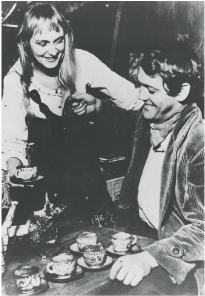
All the Boyd children helped out with the family ceramics business from an early age, and David was no exception. He studied music (he was a gifted pianist) and (briefly) painting in Melbourne, before moving to Sydney during the period 1946/47, where he helped his brother Guy Boyd (who was studying sculpture at the National Art School) establish a commercial pottery. This colourful, fashionable pottery was sold under the name of ‘Martin Boyd Pottery’ and it was a highly successful venture.
In 1947, David met the precociously talented Hermia Lloyd-Jones, a student at the National Art School. They married in 1948 and spent the rest of their life together, until Hermia passed away in 2000. From the late 1940s to the early 1960s, in Australia, England and Europe, David and Hermia Boyd made commercially successful and artistically adventurous ceramics. They left Australia to live in Europe (for the second time) in 1961, just as the Australian ceramics scene was coming of age, but there is no doubt that David and Hermia Boyd were the most successful Australian ceramicists of the post-war period.
Although they continued making ceramics in England into the 1960s, David’s preoccupations had increasingly turned to painting, and his career as a potter came to a close. A full retrospective exhibition of the ceramics of David and Hermia Boyd is long overdue, and would shed a great deal of light onto a formative period of Australian ceramics.
Damon Moon
Willunga 2012
This article was published in The Journal of Australian Ceramics, Vol 51 No 1, April 2012.
Permission has been given to make it available on this website.
© The Australian Ceramics Association 2014
http://www.australianceramics.com/
